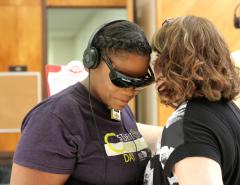
Stephen F. Austin State University senior interior design major Veronica Gilliams from Pensacola, Florida, strains to hear the five household chores Carolyn Johnson, a certified Dementia Live trainer for Heart to Heart Hospice, asks her to complete during the Dementia Live simulation. SFA students enrolled in the design graphics course participated in a Dementia Live simulation to learn how interior design impacts dementia patients and what the students can do to create more accommodating designs in commercial spaces.
“I did one task of feeding the dog, and then I didn’t know what to do. I just sat down in a chair,” said Follmar, from Colmesneil, Texas.
Recently, SFA students enrolled in Dr. Mitzi Perritt’s design graphics course experienced a Dementia Live simulation to help them better understand what it’s like living with dementia. This course introduces students to commercial interior design and interior design for special populations.
“It’s an interesting experience,” said Perritt, professor of interior design in SFA’s School of Human Sciences. “The simulation will help design students incorporate more sensitive features into their commercial spaces and health care designs.”
Carolyn Johnson, a certified Dementia Live trainer for Heart to Heart Hospice, presented the simulation and spoke to the class about dementia.
“The students walked in the footsteps of a dementia patient. They actually felt what the patients feel,” Johnson said.
To help students simulate the experiences of a dementia patient, Johnson altered their sense of touch and dexterity by placing two sets of gloves on their hands. Students wore special glasses that affected their peripheral vision, and they also were exposed to an enormous amount of auditory stimuli through headphones, Johnson explained.
Veronica Gilliams, a senior interior design major from Pensacola, Florida, said the hands-on activity was helpful in bringing the concept to life.
“Learning what a person with dementia experiences will help our design process because it puts us in their shoes,” Gilliams said. “We can take that information and put it toward our current and future projects. For example, it helps us understand noise levels and furniture placement.”
In addition to the simulation, students also researched aspects of health care design such as acute, long-term and ambulatory design.
“I now have more empathy,” Follmar said. “The simulation made me want to plan better spaces for people with dementia because I know how it feels now.”




The building s purpose is to house Alzheimer s patients who can no longer live with their caregivers due to advancement of the disease, Perritt said. During the fall semester, five teams of SFA students studied the Texas Accessibility Standards guidelines and researched city and county records for property description, lot size, restrictions and utility placement.